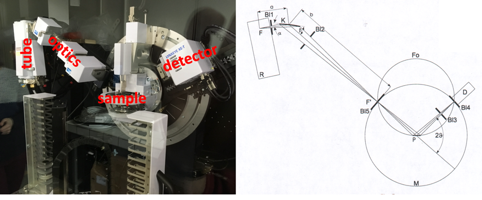Study level
BAC +4
ECTS
2 credits
Training structure
Faculty of Science
Description

This lecture, entirely provided in English, gives a basic introduction into crystallography and electron diffraction for beginners. X-ray diffraction is an important characterization technique in modern chemistry the majority of crystalline structures in inorganic and organic solids have been solved by this method. It is therefore of importance for all students to have an understanding of its basic concepts and instrumentation. The course provides explanations and principles of X-ray diffraction together with the geometry and symmetry of X-ray patterns. Beside interaction principles of X-rays and matter, it treats how to obtain quantitative intensities for single crystal and powder diffraction patterns. It naturally includes the understanding of lattice planes and the reciprocal lattice concept together with the Ewald sphere construction. Further on it gives a basic understanding of the Fourier transform relation between the crystalline structure and the diffracted intensities as well as the reciprocal lattice concept.
Electron diffraction is a complementary technique to X-rays that provides information in terms of symmetry and geometry on the materials studied. In this course, we will therefore approach the description of the method for obtaining electron diffraction pattern and their interpretation. We will be able to obtain the lattice parameters, the reflection conditions as well as the groups of possible spaces.
This lecture also serves as the introductory part to the lecture Electron Microscopy and Crystallography II
CM:14
TD :6
Objectives
- Interpretation of X-ray diffraction patterns: lattice parameters and intensity calculation
- Getting a basic understanding of X-ray diffractometers
- Getting a basic understanding of Electron Microscope
- To understand interaction mechanisms of X-rays and Electron with matter
- Interpretation of Electron Diffraction patterns: Microstructural effect, lattice parameters, reflection conditions, possible space groups.
Teaching hours
- Crystallography I - TDTutorial6h
- Crystallography I - CMLecture14h
Mandatory prerequisites
None
Bachelor in Materials Science, Chemistry or Physics
Knowledge control
Continuous control
Syllabus
basic inorganic structures, geometry and symmetry, Bravais lattices, X-ray generation, structure factor, form factor, intensities, Powder and single crystal diffraction, X-ray diffractometer, reciprocal lattice, Ewald sphere, Electron diffraction, diffraction pattern
Literature:
- Transmission Electron Microscopy, A text book for materials Science, Davis B. Williams, C. Barry Carter
- Physical Principles of Electron Microscopy, Ray F. Egerton, Springer
- and C. McKie: Essentials of Crystallography, Blackwell Scientific Publications
- Borchardt-Ott: Crystallography: an introduction, Springer
- Als-Nielsen, D. McMorrow: Elements of Modern X-ray Physics
Further information
Administrative contact(s): Master of Chemistry secretariat master-chimie @ umontpellier.fr

